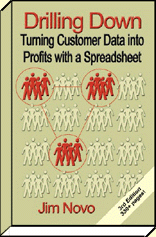
into Profits with a Spreadsheet
The Guide to Maximizing Customer Marketing ROI
The Web Retailing Example - Drilling Down Newsletter # 27: November 2002Drilling Down - Turning Customer Get the Drilling Down Book! Check out: The Marketer's Common Sense Guide to E-Metrics - 22 benchmarks to understand the major trends, key opportunities, and hidden hazards your web logs uncover. I wrote this manual with Bryan Eisenberg of Future Now, the visitor conversion specialists. To find out more about this topic: click here Prior Newsletters: In This Issue: This month we've got the usual "best of" Customer Marketing article links, oriented towards retail in recognition of the season. We also kick off the first Real World Example using the Recency Metric with The Web Retailing Example, and a fellow Driller wants to know what the heck Data Mining really is and when one should use it. Let's do some Drillin'! Best Customer Retention Articles This section flags "must read" articles moving into the paid archives of trade magazines before the next newsletter is delivered. If you don't read these articles by the date listed, you will have to pay the magazine to read them from the online archives. The URL's are too long for the newsletter, so these links take you to a page with more info on what is in the article and a direct link to the article. Note to web
site visitors: These links may It's Outta Here A Housefile Divided
Recency: The Web Retailing Example "Yes, things are sweet," thinks the owner of IMissAsia.com (not the real name of the site), ending a phone conversation with a supplier. Who would have thought! In just one short year, with the remains of the dot-com bust scattered all about, IMissAsia.com was running at sales of $25,000 a month. With an operating margin of 40%, "The Miss," as the owner liked to call the site, was going to generate about $120,000 this year pre-tax - certainly enough to keep the spouse warm, fed, and reasonably happy. Who knows what next year would bring? Could the business double in size? The owner figured The Miss could do about $2 million in annual sales with the current infrastructure set up - a web site / shopping cart that cost about $40 a month and assorted software / hardware purchased for a total of about $1,000. The owner put up the very simple web site and ships every box - the order management system is highly integrated with both the shopping cart and UPS WorldShip, so order processing and customer service are a breeze. All other costs of the operation were basically variable to sales. Sweet, indeed. Of course, the owner / only employee has done a lot of things right in the first place. IMissAsia.com is a site for people who used to live in Asia and now don't, and are scattered all over the world. The core business idea takes natural advantage of what the web is very good at - aggregating niche vertical demand. A person who used to live in Asia but now doesn't is cut off from a lot of things they liked and now "miss" - food, clothing, beauty items, culture. IMissAsia.com aggregates all those things into one web site, and then offers it as a "one stop shop" to a very geographically dispersed group of people all over the world. IMissAsia.com is "patient zero" in all this, the intersection of diverse needs with a fragmented customer base - a perfect application for the web. The site is set up smartly, using mostly free resources to attract and hold on to traffic - news feeds, free newsletters, and discussion boards. The store is tightly integrated into all the content, so there are many opportunities to get visitors to take a peek at the merchandise. The Miss gets pretty high natural search rankings for important search terms because it's a plain HTML site without a lot of script and database-driven components, and has been written carefully with search engine optimization in mind. In other words, the site is a little cash machine that requires almost no maintenance. Shipping packages, customer service related to those shipments, and the newsletter are about all the day-to-day work done on the business. However, storm clouds are on the horizon. Response to the weekly newsletter is falling, and the owner is thinking of going bi-weekly or even monthly. In addition, to try and keep response up, the owner has been discounting more aggressively in the newsletter, and this practice is starting to depress margin. This situation is of deep concern to the owner, because the newsletter generates a big chunk of sales volume. Niche markets are a double-edged sword. While they fit perfectly into the natural search-driven model of the web, by definition, niches are small. This kind of business has a tendency to ramp up very quickly, but then plateau as the entire niche is discovered and filled out. You can quickly capture 80% of the market, but then there is nowhere to go. And as soon as you are successful, you will attract copycats, who chip away at your share, often undercutting your prices in start-up mode. The copycats have now started to appear. How will the owner grow the business when it already dominates the niche, and defend against the copycats? Not to mention address the worrisome situation with the newsletter. So, what the heck does any of this have to do with Recency? Everything, fellow Drillers, absolutely everything, in more ways than you could possibly guess. Next month, we'll find out just how important - no, critical - Recency is to the future success of IMissAsia.com. To read the next installment of Recency: The Web Retailing Example, click here. -----------------------------------------
Questions from Fellow Drillers Note to readers: the business being discussed below is an online / offline stock brokerage. Q: We're trying to develop an action-oriented customer retention program and are starting to build our trip wire metrics. I've been "hit up" by some of these firms that specialize in data mining - all of the neural networks stuff - can you help me understand why I should NOT go with one of them, versus develop this internally using your approach? A: I don't know that my approach would be superior without understanding your objectives and a bit more about your data. But I can give you some "need to knows" about data mining in general that should help you decide... Note to the data mining community: please don't hate me for stating the case in plain English. People really need to understand this stuff. If you are different, then simply prove it to your prospects. Love ya, I really do. Understand that mining was originally developed for use by highly advanced modelers, not beginners. These are people who have used every human-based tool to do modeling and have squeezed every bit of info out, but want more. The only way to get more is to use a machine to look for patterns. The fact these services are sold to people just beginning the data modeling process is not particularly honest, in my opinion. Here is what may happen: you will pay the money and spend the effort and they will come back and tell you that the Recency and Frequency of the trades are key to defection - and say their miner figured it out. And it did. The fact you could easily have already known that with a few simple tests is beside the point. It is the ability of mining to improve on human modeling by 1% that is valuable, the ability to "go granular." If you have never done any human-driven modeling, you will see a tremendous benefit in using your first models generated by the miner. But the real question is this: could you have generated something nearly as good yourself, at a fraction of the cost, using "universal" behavior models? Mining works best (meaning, delivers highest ROI) under these conditions: 1. Your data is super clean. Reasons the above are true: 1. It's a machine, it can't distinguish between bad and
good data. Dirty data = dirty results. So my advice is this: I think it is always best to make sure you have generated enough meaningful data for the miner to analyze. To do this, you have to do some basic modeling yourself and try some things, see how it goes. Doesn't have to be very complex, just generate some activity along the lines of the objective you have. Then if you are not satisfied, call in the miners. At least you will then have the kind of data that the miner can use, and will know enough to be able give the miner instructions. Another alternative: hire a real human modeler for a time, and see what they come up with (not me, I use universal models or hire a modeler myself). I guarantee a hand-built regression model will be much better than using RFM, and much better than what the miner will come up with, because human intuition plays a huge role at the beginning of the modeling process. At the end of the process is where mining comes in, when it becomes an issue of "brute force." And if you do hire a modeler, be prepared for the first question they are likely to ask: do you have any results I can look at from universal models like Latency, Recency, or RFM? Jim Any comments on the newsletter (it's too long, too short, topic suggestions, etc.) please send them
right along to me, along with any other questions on customer Valuation,
Retention, Loyalty, and Defection right here. Copyright 2002, The Drilling Down Project by Jim Novo. All rights reserved. You are free to use material from this newsletter in whole or in part as long as you include complete attribution, including live web site link and/or e-mail link. Please tell me where & when the material will appear. |
|
|
|
Slow connection? Same content, less graphics, think Jakob Nielsen in Arial - Go to faster loading website Contact me
(Jim Novo) for questions or problems with anything on this web site.
| |
![]()
|
Get the book with Free scoring software at Booklocker.com Find Out Specifically What is in the Book Learn Customer Marketing Concepts and Metrics (site article list)
|
|
|
